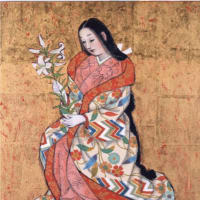Recently, Professor David J. Kalupahana presented a new interpretation of Nagarjuna as an empiricist in his translation with commentary to the Mulamadhyamakakarika.(16) Suspecting the validity of the negativistic (prasangika) interpretation of Candrakirti, he adopted a positivistic attitude towards the texts of the Middle Way. He took a fresh look at Kumarajiva's Chung-lun, and found no justification whatsoever in looking at Nagarjuna through Candrakirti's eye when there was a more faithful and closer disciple of Nagarjuna in Kumarajiva.
It is a matter for the Buddhist special ists to judge whether this interpretation is historically justified, but such a radical empiricism is important in its own right because the sceptical and negative attitude towards language is meaningful only if there is something absolutely positive at the very outset of experience. Moreover, it is under the strong influence of Nagarjuna through Kumarajiva's translations and commentaries that the tradition of Eastern Buddhism favors the paradoxical identification of the phenomenal world(samsara) with the ideal(nirvana). This tradition of Mahayana Buddhism may explain the popularity of An Inquiry into the Good in Japan. The experience which makes us realize sunyata must be pure in Nishida's sense, and we cannot be content with the negative way(via negativa) of deconstruction but try to discuss "pure experience" just in the same way as Buddha preached "dependent origination". The Middle Way which transcends abstract controversies between opposing views would become nihilistic if we are not enlightened at the very outset by the absolutely positive light, a light defined by Nishida as "pure experience" which, although beyond language, can be a revelation through linguistic conventions (vyavahara) . The task of philosophy is "to frame a coherent, logical, necessary system of general ideas in terms of which every element of our experience can be interpreted" according to Whitehead. (17)
The experience which Whitehead's speculative philosophy seeks to clarify must be so radical and pure that it may break through what Nishida expressed as "the contradictory self-identity" of one-many, subject-object, and divine-human.(18) The way in which this contradiction is expressed, resolved or synthesized in the unity of opposites is different among philosophers, reflecting the climate of thoughts which they inherit in their own traditions. Cobb stressed the necessity of dialogue between East and West for the mutual self-transformation, and put forward the thesis of complementarity between Christianity and Buddhism in so far as they are expressed, and crystallized into official dogmas in linguistic forms. A successful dialogue can reveal the nature of pure experience out of which these outer forms are born, signifying a small portion of totality by abstraction. One of the important features of Nishida's later philosophy is the concept of topos (Basho) which Cobb found baffling in his dialogue with the Nishida School. Nishida's logic of topos in his later developments of the theory of pure experience is too large a topic to be discussed in detail here. Instead, I shall present the thesis of complementality between topos and process in both Nishida's and Whitehead's theories in the next section.
(Comments on how to translate "concrescence" in Japanese)
I usually translate "concrescence" into "genjyo (現成)" in Japanese. This word is obsolete in modern Japanese just as "concrescence" is in English; it is the very word that the Zen Buddhist D6gen in the thirteenth century frequently used in Shobogenzo (正法眼蔵 =The Eye and Treasury of the True Law) to signify the actualization of the absolute and infinite in "the here-present" in the concrete act of experience. He said that the ultimate aspect of actuality is "this body, this mind, this world, this wind, and
this rain, this sequence of daily going, living, sitting, and lying down, this series of melancholy, joy, action, and inaction, this stick and wand, this Buddha's smile, this transmission and reception of the doctrine, this study and practice , this evergreen pine and this ever unbreakable bamboo." ("the True Nature of Dharmas" In Shobogenzo)
At the 1985 conference of AAR, Steve Odin pointed out that Whitehead's epochal theory of time has something common with Dogen's "Uji有時=being-time)" in their conceptions of time as "discontinuous continuity". (19) Time is conceived as a continuous series of discontinuous epoch-making monads; Whitehead and Dogen termed each temporal monad "the concrescence of an actual occasion" in the extensive continuum and "the genjyo of being-time(有時現成) " in the locus of "nikon(而今 = the Now)" respectively.
Dogen was a great exception among other Zen Buddhists in that he was not satisfied with the via negativa in Zen Buddhism, i.e. the tradition of "the direct pointing to the Mind and no reliance on letters"; he had quite a low opinion of the significance of the silence of Vimalakirti, which was generally highly commended in this tradition.
In a glossary of Shobogenzo "genjyo" occurs 262 times in important contexts of Dogen's thoughts whereas "nothingness (無)" and "emptiness (空)" occur only 30 and 51 times respectively. (20) The characteristic usage of "nothingness" and "emptiness" is pejorative in such a way that "(the absolute is) neither being nor nothingness" or "(we must transcend) both emptiness and being" On the other hand, "genjyo" is always used in an absolutely affirmative way as it signifies the actualization of enlightenment (genjyokoan) . This seems to suggest that the proto-word (Grundwort) which transcends the relative opposition of "being" and "nothingness" was neither"(Absolute) Nothingness" nor "(True) Emptiness" but rather "genjyo", the dynamic and concrete activity in " the here-present."























